SurveyMonkey’s playbook for building a customer centric culture
Build your own program for measuring—and improving—employees’ connection to customers.
Think fast: Does your job have a direct impact on your company’s customers?
Sometimes the answer to this question is easy: Customer support pros spend their days helping people with their issues, while people in roles like product design make sure those issues never happen again. And of course, most people in leadership positions make dozens of decisions a day that influence the customer experience.
But what about employees in departments like HR or accounting? Well, you’re not likely to hear people say that billing errors or interactions with unengaged employees make for a great customer experience.
The point is, there’s a good chance that your job does influence customers—even if it’s not immediately obvious.
More importantly, bringing a customer-focused mindset to work can make you better at your job and even help you enjoy it more.
If we’re not reminded of the people we’re helping, work can start to feel less meaningful, less engaging—less important. Worse, when we forget to take customers’ feelings and opinions into account as we make day-to-day decisions, it can result in bad experiences, churned customers, and missed revenue.
That’s why it’s so important that your organization adopts a customer centric culture, where everyone feels they’re working toward a common goal of serving customers and improving their experience.
How can your organization actually build and maintain a healthy customer centric culture? Not so long ago, we asked ourselves this same question here at SurveyMonkey and started a journey to find out for ourselves.
In this guide, we’ll teach you everything we learned along the way and give you the framework we used to improve customer centricity at our own company by:
- Measuring customer centricity: Understand how close to the customer everyone in your company feels, across each department and office.
- Identifying areas for improvement: Find out where you should focus your initiatives and energy to ensure you’re having the biggest impact.
- Acting on our findings: Choose from the top 6 initiatives we use to build and foster a customer centric culture. Then come up with your own!
What is a customer centric culture and why is it important?
Customer centricity is the act of putting your customers at the center of everything you do, by listening to them, learning about their needs, and acting on what you learn.
A customer centric culture is one where your organization aligns itself around providing a great customer experience, including everything from how you set high-level goals to how your employees do their day-to-day job.
In a customer centric culture, employees feel “close” to their customers—they understand their needs, how their work affects their experience, and what they can do to make it even better.
So why does customer centricity matter? To start:
- According to our own research, 75% of customers say they lose trust in an organization after a poor in-product experience.*
- The same study found that 71% of customers say they place less trust in an organization after a poor customer service experience.*
- McKinsey found that anywhere from 20-50% of a prospect’s buying decision is determined by what customers say about you.
The study collected responses from more than 3,000 individuals in the U.S., Canada, and the UK, between October 5th to October 7th, 2018. These individuals were selected from a pool of more than 3 million people who take surveys on SurveyMonkey every day.
And here are some data points that show how it can help your organization improve employee morale and prevent attrition:
- According to another SurveyMonkey study, employees who feel like their work has a significant impact on customers are 27 percentage points more likely to find their jobs meaningful than those who don’t (76% vs. 49%).
- The same study found that 83% of employees who think they work for organizations that prioritize customer satisfaction are at least pretty sure they’d stay with them for at least 2 years.
SurveyMonkey’s journey to measuring customer centricity
Customer feedback surveys have always been the number one use case for people using SurveyMonkey. And like so many of our own customers, we use surveys to listen to the voices and opinions of the people who matter most to our business.
But until we started taking customer centricity seriously, we suffered from the same problem many of our customers do: The feedback we collected often didn’t make it in front of the people making decisions or into the hands of the teams who needed it to do their jobs better.
It’s hard to understand how big the gap is between employees and customers until you actually start measuring. How close to your customers do your employees actually feel? Which teams feel out of the loop about what your customers want?
To get some answers, we developed a customer centricity survey that’s designed to survey our own employees. It helps us understand:
- How close our teams feel to customers
- How well we’re advocating for and acting on customers’ needs
- How effective our customer centricity initiatives are
- How we can improve employees’ relationship with customers
How connected to customers is your team?
Use our free customer centricity survey template to measure how close your team feels to its customers.
Measuring customer centricity at SurveyMonkey has had a profound effect on how we’ve approached the issue. The more we’ve been able to learn, the more effective the initiatives (which we’ll talk about later in this article) we’ve implemented have been.
Our friends at Box have also figured out how powerful surveys are in measuring customer centricity, and, ultimately, in becoming a customer centric company. Box’s Chief Customer Officer, Jon Herstein, told us that they’ve integrated customer centricity into their bi-annual employee surveys.
Learn more about how Box measures customer centricity and operationalizes it across their organization by watching our on-demand webinar with Jon.
SurveyMonkey’s framework for measuring and improving customer centricity
As we—and Box—have found, it’s important to get a baseline of how customer centric the culture at your organization is before you start drafting a plan to address it. We recommend starting with our customer centricity survey template. You can use the template as-is, or pick and choose the questions you like, and customize them to fit your needs.
As you dive into your survey results, you’ll start seeing areas for improvement—concepts, departments, or office locations that need more attention.
Based on the types of issues you see and where you see them, you’ll be able to take action. We’ll give you some example initiatives that you can use at your organization to address specific areas of customer centricity later in this guide, but you shouldn’t feel limited by them. Get creative and try your own methods!
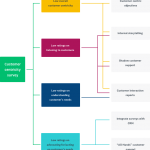
Finally, it’s a good idea to run this survey repeatedly in order to keep tabs on customer centricity at your organization and whether your initiatives are making a difference. If you’re planning to do this (which we strongly recommend), avoid changing the survey. If you do, you may be making unfair comparisons between time periods.
How often should you send the survey? You’ll want to run it enough times throughout the year to measure the impact of your initiatives, and to identify new ones worth pursuing. On the other hand, over-surveying employees can be counterproductive. It can dissuade them from taking your surveys in the future, or take them without being thoughtful about their responses—which we call “satisficing.”
We recommend you survey employees at the rate we’ve found to be best: around once every 6 months.
Pro tip: Use our Recurring Surveys feature to automatically remind you to resend your customer centricity survey when it’s time to measure again.
Once you’ve sent your survey and you’ve gotten all your responses back, it’s time to start digging in to the results.
Make sense of your responses
Interpreting your survey data is one of the most important stages of this process. To ensure you’re not missing anything, it’s important to make sure you’re extremely thorough in your analysis. Understand your results from top to bottom before you share your findings and take action.
Each time you send your survey and get back your results, we recommend you follow this framework to ensure you’re not missing anything:
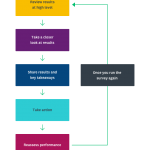
Before you start digging in to specific areas and groups in your survey results, it’s important to look at your results as a whole to understand what the main takeaways of the survey were. Here are a couple simple steps to follow:
1. Check your response rate
It’s important to get as many employees to take your survey as you can so that you get an accurate representation of your teams’ sentiment. Also, a higher response rate increases your chances of receiving more valuable ideas for improving employees’ connection with customers.
If you need help drumming up responses, ask managers to remind their direct reports. You can even offer an incentive.
2. Look at the overall responses from your closed-ended questions (multiple choice, dropdown, checkbox, etc.).
As you scan through the feedback, look for the broadest, most obvious themes: What areas of your customer centric culture are performing well? Which need to improve?
To help you find the answers to these questions and explain them to others, use our customizable charts.
As an example, here’s a chart for the question: “For the following areas, how well do you think we’re doing as a company”:
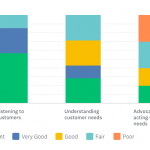
At a glance, you can tell that employees think your organization is doing a fantastic job at “Listening to customers,” decently at “Understanding customer needs,” and has more room for improvement on “Advocating for and acting on customer needs.”
This easy-to-understand summary of your survey is the just the thing to use in a presentation about customer centricity at your company or as a reference sheet for talking points about your progress.
3. Now look at your open-ended responses
Our text analysis feature uses a word cloud to present the relative relevance of each word/phrase. This lets you quickly pinpoint themes from the individual responses without having to manually sort through every single answer you receive.
Meanwhile, Sentiment Analysis uses machine learning and natural language processing to categorize responses as positive, neutral, or negative. The feature then shows you the distribution of responses that fall under each category.
Still curious? Learn more about both of these features!
4. See how your organization’s customer centricity is changing over time.
Tracking change—hopefully improvement—over time is possibly the most important thing you can do with your survey results. Our Data Trends feature can do the heavy lifting for you. Use it to evaluate how different facets of customer centricity are evolving at your organization.

Take a closer look at the feedback
While the top-level results may be the easiest to communicate or make a point with, seeing how individual groups respond to your survey is more helpful for understanding whether you’ve got a customer centric culture at your organization. Here’s how to drill down on your results:
1. Filter the responses by department, location, and job level.
Just by the nature of their roles, some employees may feel their jobs are more customer centric than others. For instance, an HR recruiter is significantly less likely to interact with customers routinely than, say, a customer success manager.
You can remove this “role bias” by filtering your results across individual departments.
The same logic applies to factors like location and job level. In the case of the former, certain offices may offer more opportunities to learn from customers. For the latter, perhaps management gets to engage with customers more often than the rest of the organization.
This type of information is particularly useful for deciding where to aim your customer centricity initiatives and spend your resources. When you find particular groups that need extra attention, give it to them.
There may be other criteria that naturally make certain groups of employees more or less customer centric. It’s your job to identify and filter by them when reviewing your results.
2. Review your individual open-ended responses
In our customer centricity survey template, we ask a couple of open-ended questions to allow respondents to give their own thoughts and ideas for how to be more customer centric. It’s a good way to make them feel involved—and get some good crowdsourced ideas for how to engage them.
Any response can mention a customer centric initiative worth trying, so don’t skip any!
Also, as you read through the responses, we recommend that you tag each by a category you predefine. This will help you quickly find the type of responses you’re looking for later on.
For example, some of the tags we use to understand how our initiatives are performing include: “Product related,” “Bring customers to life,” and “Company/org strategy.”
After you’re done tagging, you can see the distribution of responses that fall under each category, which you can then filter by.
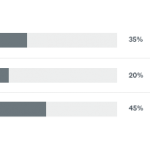
3. Compare your customer centricity survey results with other data
Customer centricity is an interesting and useful concept to explore, especially if your aim is to build a customer centric culture. However, it’s the connections to employee engagement and customer satisfaction that will truly affect your company’s bottom line.
As you begin measuring customer centricity in your organization, compare it to the employee engagement and customer experience data you collect from other surveys. Do any of them mention concepts related to customer centricity? Do you see rises or falls in groups that your initiatives focus on?
Make sure to do the extra legwork to compare these data sources. Showing how customer centricity is related to customer experience and/or employee engagement can help validate its value to your organization.
Share your results
Now’s the time to put your survey responses to work! We’ve got a whole separate section below on initiatives you can use to build a more customer centric culture. But in the meantime, it’s important that you share your results with everyone.
1. Make the high-level feedback accessible to any employee.
If employees take the time to fill out your survey, it’s likely they’ll want to see your results. You don’t necessarily have to present your findings to the entire company, but you should absolutely make them available and make sure everyone knows where they can find them.
Here are some steps for sharing your findings:
- Post them on a page any employee can access and that you can update over time, like a company Wiki.
- Use charts to showcase the highlights of your results from closed-ended questions.
- Make sure to describe the key takeaways of each chart with text alongside of them.
- Highlight some of the most interesting and thoughtful open-ended feedback.
- Contextualize the results by comparing them to previous surveys.
- Outline how your organization plans to address the responses over the coming months.
2. Present your findings to leadership.
If you give decision-makers at your company a clear picture of the state of customer centricity at your organization, along with a clear strategy for how to address it, they’re much more likely to provide the backing you need to launch the organization-wide initiatives you’re after.
Before you present to them, try to tie improvements in customer centricity to improvements in the customer and/or employee experience. The correlation(s) can add credibility to your presentation and earn you even more support.
Our VP of Product Marketing and Voice of the Customer, Christine Rimer, explains the value she experienced from presenting the results to executives:
3. Present department-specific results to the leaders of each team.
If a particular department or team doesn’t feel very customer centric, that’s something the leader of that group will want to know. We wouldn’t necessarily recommend that you present your findings to every department head, but you can create and save views of your results in SurveyMonkey to easily share with them if they’re curious. For each view:
- Filter the results by department.
- Make sure your charts effectively convey the takeaways of each closed-ended question.
- Include open-ended responses, data trends, and individual responses.
- If you’d like to better control who sees it, make the view password-protected.
Pro tip: If you want leaders of specific departments to see how they rank, use Compare Rules. More specifically, instead of following step 1 from above, you would create a rule that checks off each department. The resulting view allows you to compare the responses from one department to another across every question.
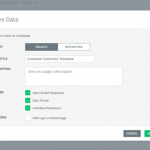
Repeat and re-assess
The more times you launch your customer centricity survey, the more useful the results become. Each time you send it, go through a process of reviewing and sharing the results.
And remember, if you run other employee engagement and customer satisfaction surveys, continue to track their results. If you can find a positive correlation from either survey with your customer centricity data, it can imply that your customer centric initiatives are having an effect.
6 customer centricity examples for building a stronger culture
Once your program for measuring customer centricity is up and running, it’s time to start exploring what you can do to build a better connection between your employees and customers.
Let’s quickly refer back to the chart from the beginning of this guide. Depending on what you’ve found in your survey, you may choose to prioritize different initiatives for boosting customer centricity.
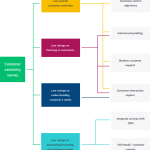
In the following sections, we’ll walk through each of the 6 initiatives that have had the greatest impact on customer centricity at SurveyMonkey. And we’ll provide a few reasons to adopt—or stay away from—each of our customer centricity examples.
1. Customer centric objectives and key results (OKRs)
We define OKRs in two parts: Objectives are aspirational goals that help us reach and exceed company targets. Key results are how we measure ourselves against these objectives.
Every year, we set new OKRs at the company and department level. They get reevaluated every quarter and shape the individual OKRs our team sets.
OKRs allow our team to continually align on what they need to accomplish individually, as well as understand how their responsibilities contribute to meeting the larger company goals.
Adding customer centric company OKRs trickles down to department objectives, and then to individual goals. Once this happens, our entire team becomes motivated to improve their connection to customers—as they’re held accountable for doing so. All they need are the opportunities to interact with customers, which our following customer centricity examples provide.
Add customer-focused goals in your OKRs (or whatever they’re called at your organization) when employees:
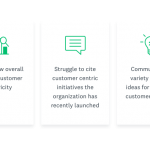
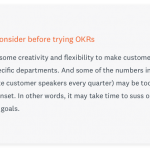
The company-level OKRs have to be pretty broad to fit the entire organization. To give you an idea of how they can look, here’s some we’ve developed:
- Improving our Net Promoter Score® (NPS) (leading metric for measuring customer loyalty) by a certain number of points every quarter. This involves using our NPS solution, SurveyMonkey CX, to measure and track our score over time and share feedback with customer-facing teams so they can implement improvements.
- Delivering 99.9%+ availability on our platform.
- Collecting 100 or more customer interaction reports in 2018.
2. Customer Interaction Reports (CIRs)
As a leader in online surveys, SurveyMonkey has millions of customers who use our platform every day. When one of our employees meets someone who uses SurveyMonkey (which happens often), we ask them to fill out a brief survey, which we call CIRs (pronounced “cheers!”). In it, the employee tells us:
- Who the customer is
- How they use SurveyMonkey
- The value they get from running surveys
- Their overall impression from using SurveyMonkey
Once an employee submits their report, it gets shared internally to the entire company. This allows employees everywhere to see the impact their work has on everyday SurveyMonkey users, which not only increases employees’ empathy toward customers, but also puts our team in the habit of learning from customers.
Use CIRs when:
- Employees across departments don’t feel close to customers
- There’s a high percentage of fair and poor ratings on listening to customers and understanding their needs
- Several employees explicitly ask to speak with customers
How SurveyMonkey implements CIRs:
- An employee identifies a customer and speaks to them directly, either over the phone or in-person.
- The employee fills out a survey about their conversation.
- Then, using our integrations with Zapier and Slack, the employees' responses to the survey are automatically sent to a public Slack channel in a neat, easy-to-read format.
Pro tip: If you want more employees to participate, and/or you want them to get even more jazzed about submitting a report, offer some sweet incentives. At SurveyMonkey, employees who submit a report can get anything from a cute puppy sticker to a paid trip, so get creative!
Learn more about how you can use customer interaction reports to build a culture of customer centricity!
3. Internal customer storytelling
For more formal or high-profile customer stories, our Voice of the Customer team, with the help of internal guest writers, creates full-scale blog posts—or even videos—and posts them on our internal Wiki for everyone to see. Every time a new story gets posted, employees get notified by email.
While not necessarily mutually exclusive with CIRs, these stories tend to be related to critical business objectives for the company and feature high-profile customers.
Pro tip: Sourcing a steady stream of customer stories can be challenging, especially if you don’t have enough time or resources to dedicate. These assets can be educational for your colleagues, and they can fuel your marketing campaigns and sales efforts with the social proof that's needed to build trust with prospects.
Use internal customer stories when your survey results display:
- A low overall customer centricity score
- A high percentage of fair and poor ratings on how close employees feel to customers and/or listening to customers
- Explicit feedback to hear more from customers

Here’s a look at how we deliver customer storytelling to our employees:
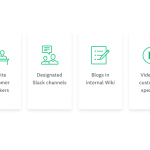
4. Shadow customer support
If you don't interact with customers every day for your job, it can be easy to lose touch with their needs or with how they experience your product. To prevent this from happening, SurveyMonkey allows employees in non-customer-facing roles to shadow the people who help our customers with their problems every day: the customer support team.
Hearing directly from customers who are having issues immediately puts things into focus: Do people experience your product in the ways you imagined? What did you think was obvious or intuitive, but really wasn't? There's no better way to find out than to hear it directly from the customer's mouth.
One of our product managers, Prasad Sawant, learned first-hand how interacting with customers can effectively put his ideas to the test:
Implement a similar program when your survey results show:
- Low overall customer centricity and weak levels across departments
- A high percentage of fair and poor ratings on listening to customers
- Requests to shadow colleagues and/or hear from customers directly
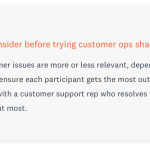
Here’s the low-down on how SurveyMonkey runs the customer support shadowing program:
- Employees sign up by emailing the head of our customer support training.
- Each employee is assigned to shadow one of 3 chosen customer support representatives.
5. "All Hands" customer support
This customer centric initiative goes a step further than shadowing. It gives our employees in product and engineering the chance to get in the action by actively working to resolve real customer issues, responding to customers who contact SurveyMonkey with issues over email.
This active approach helps participants better connect with customers. Also, it allows participants to return to their daily tasks with a better understanding of the issues that need to be prioritized and the features that should be added to the product roadmap.
Try this hands-on approach when your survey’s results reveal:
- A high percentage of fair and poor ratings on advocating for and acting on customer’s needs
- Product and engineering teams have low customer centricity scores

Here’s how SurveyMonkey executes it:
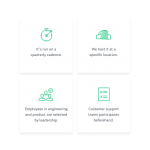
6. Integrating the survey into our customer relationship management (CRM) platform
Employees who interact with customers every day can also benefit from better client feedback. Any additional context can help these employees understand how satisfied clients are with your product or service, and even find out specific aspects of it that they like or don’t like. Bringing this type of knowledge to employees’ everyday interactions with clients is at the heart of what customer centricity is about.
Deliver customer data directly to your team, automatically, by integrating SurveyMonkey with your CRM platform. The survey data can then map back to the appropriate respondents’ profiles in your CRM platform, allowing your customer-facing team to easily find—and act on—the feedback.

Integrate SurveyMonkey with your CRM when you find:
- A high percentage of fair and poor ratings on advocating for and acting on customer’s needs
- Customer-facing employees explicitly ask for a way to access timely feedback
Here’s a simplified breakdown of how our customer support team uses our Salesforce integration:
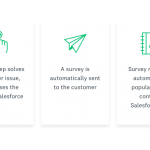
Take your customer centricity to the next level
Learn how you can automate your customer experience program with SurveyMonkey CX.
No matter the type of role you’re in, you can influence your organization’s customer experience. To ensure your impact is positive, your organization needs to create and sustain a customer centric culture, which requires: measuring customer centricity, identifying areas for improvement, and acting on your findings. Once your team adopts this framework, your customer experience, employee engagement, and bottom line are sure to improve.


